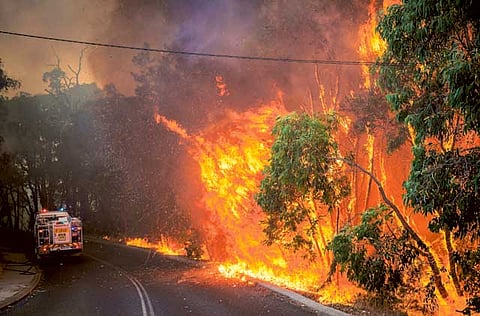Australian heatwave set to worsen as fires rage
Commuters urged to leave work early, with the heat expected to cause significant delays

Melbourne: Australians sweltering through a severe heatwave were warned yesterday that the worst is yet to come, with hundreds of fires raging in several states and temperatures nearing record highs.
Most of southeast Australia has been sizzling in a heatwave that triggered a devastating wildfire on the west coast, razing 55 homes and claiming one life on Sunday.
The mercury has soared above 40 degrees Celsius (104 Fahrenheit) for successive days in South Australia and there is a total ban on recreational fires in neighbouring Victoria where players at the Australian Open fainted and vomited in blistering conditions.
Play was halted on yesterday afternoon due to the extreme heat, and a Melbourne school gardener, aged 76, died after collapsing on Wednesday in the grounds.
Commuters were urged to leave work early to ease peak-hour pressure on trains and trams, with the heat expected to cause significant delays and a wild evening hailstorm forecast.
Health officials in South Australia said 129 people had presented to hospital in the past four days with heat exhaustion and dehydration.
In Victoria state, currently experiencing its longest stretch of hot days since 1908, there were 109 cases and ambulance services reported almost double the average number of call-outs for heart attacks.
Wildfires raged across both states, with South Australia’s Country Fire Service saying there were some 800 blazes of concern and an “escalating fire pattern over the next 48 hours”, with total fire bans across the state from Friday.
“We may be reaching quite a dangerous phase in this heatwave and it’s important that people are well aware of those risks,” said state premier Jay Weatherill.
“Because we appear to be getting closer to some of the cooler weather does not mean that the threat is receding. If anything, the threat is increasing.”
Acting chief meteorologist for South Australia, John Nairn, said the state capital Adelaide was on track to eclipse its hottest ever temperature of 46.1 Celsius, recorded in January 1939, briefly earning it the title of hottest city on Earth on Thursday.
“We’re seeing today as a day where we may well set a record. We have a clear-sky day, the potential is there to reach that 46 degrees in Adelaide,” he said.
Cyclists and spectators in Adelaide for next week’s Tour Down Under road race were urged to be extra careful venturing into the heat, warnings that were echoed for the large crowds in Melbourne for the Australian Open.
In Victoria, 1,000 fires have been reported in the past 24 hours — mostly due to lightning strikes — and 39 had taken hold, with four declared emergencies.
Today is expected to bring horrific conditions for fire crews, with strong gusts and a wind change forecast before a cool front arrives.
“It’s the worst scenario possible but it’s a reality,” said fire commissioner Craig Lapsley.
Officials are warning of some of the worst fire weather in the state since 2009, when the so-called Black Saturday inferno killed 173 people and razed entire towns.
A heatwave ahead of that disaster killed 374 people in Victoria and another 64 in South Australia.
The Climate Council think tank said new research had showed that heatwaves were becoming longer and more frequent in Australia, with heat records toppling three times as often as cold records and the number of hot days more than doubling.
“Australia has always had hot weather. However, climate change is loading the dice towards more extreme hot weather,” said the council’s Will Steffen.
“The current heatwave follows on from a year of extreme heat, the hottest summer on record and the hottest year on record.”
Heatwave to affect commodities?
Meanwhile, there is growing concern that prolonged heatwaves would threaten Australia’s agricultural production and undermine its policy of being the “food bowl of Asia”, analysts said.
“It will be much harder to maintain production if you have such extreme weather events,” said Paul Deane, senior agricultural economist at ANZ Bank.
“Higher temperatures tends to lead to more evaporation of any rain, all of sudden the water availability for crops is reduced, which will have a big impact on crops like wheat and sugar.”
Australia is the world’s second largest wheat exporter and the third largest raw sugar exporter. While the wheat harvest is now complete for the 2013/14 season, saving broadacre farmers from the brunt of the current heatwave, livestock farmers across the east coast are struggling.
Benchmark Australian beef prices, the Eastern Young Cattle Indicator, have fallen almost 10 per cent in the last month as farmers, struggling to find sufficient water and food for animals, send increased numbers to slaughter.
Australia’s cattle herd will fall to 25 million head during the 2013/14 season, the lowest since the 2009/10 season, due to increased slaughtering, the Australian Bureau of Agriculture and Resource Economics and Sciences said in December.
Australia, the world’s third largest beef exporter, is forecast to sell 1.085 million tonnes in the current season, buoyed by increased slaughter rates and strong Chinese demand.
It must invest in greater research to understand how the intensifying heatwaves will have an impact across a wide range of infrastructure, experts say.
Sign up for the Daily Briefing
Get the latest news and updates straight to your inbox



